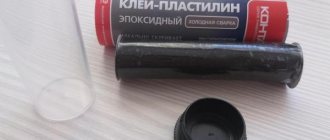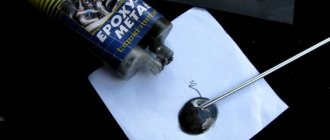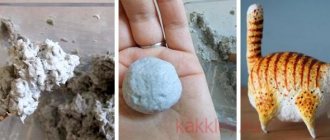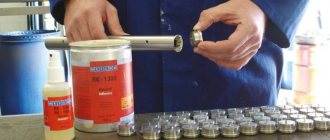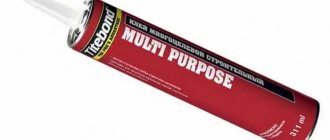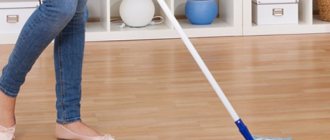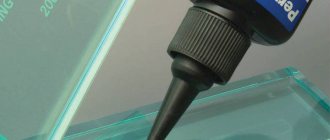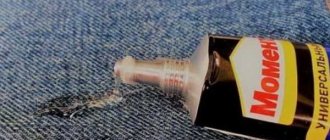The question of how to glue rubber to metal arises when you need to glue a rubber seal to a car door, fix a gasket on a metal part, and also carry out other types of repairs. Rubber-based adhesives that are dissolved in a specialized composition are well suited for this purpose. After polymerization, the two-component mass forms a high-strength structure that reliably connects dissimilar materials. Almost all types of adhesives not only connect elements, but also additionally perform the function of a sealant.
The DIYer always needs a good glue to bond metal to rubber bases.
Composition characteristics
Metal and rubber parts cannot be fixed with universal mixtures. A rubber-based product will help connect surfaces with different adhesion. The glue hardens evenly, maintaining the elasticity of the seam. The substance allows you to firmly bond materials with different structures.
The composition for rubber and metal penetrates into the smallest cavities and cracks, filling the space with a fixing mass. To enhance or change the initial characteristics of the base raw material, the following is often added to the mixture:
- vulcanizers;
- plasticizers;
- polymer resins;
- cross-linking ingredients.
What kind of glue should it be?
A composition with increased adhesive characteristics is capable of firmly gluing, the seam of which will be reliable and elastic. Additionally taken into account:
- operating temperature of the glued part;
- indoor humidity;
- load exerted on glued surfaces;
- what elastic properties should the part have after gluing;
- chemical aggression towards treated surfaces.
Be sure to read the instructions; the manufacturer must indicate in it that the composition is suitable for rubber and metal alloys. After drying, a high-strength, water-resistant seam should be formed that maintains its strength at low and high temperatures.
To glue parts in cars, you should buy products like “liquid rubber”; they create a single plane with the treated surface, which makes the seams visually invisible. When gluing silicone rubber, a mixture is used, the packaging of which states that it is for elastic materials.
Types of glue: TOP-8
Construction and hardware stores offer a huge variety of fixing solutions. Not every option on sale is suitable for gluing metal to rubber. Let's look at eight popular types.
«88»
The solution consists of phenol-formaldehyde resin, ethyl acetate and rubber. Viscous beige mass suitable for dissimilar surfaces. The universal substance is used for both small household work and large industrial repairs. According to the type of gluing, cold and hot types are produced.
Glue “88” has high thermal and moisture resistance. After drying, the seam can withstand temperatures ranging from -30 to +85 C. The fixing composition quickly sets, after which it is not afraid of mechanical stress. The ingredients are safe for humans and pets, so can be used indoors.
Option for rubber and iron Source kraski-net.ru
The product has many modifications. If you need to glue rubber to metal, then “88-SA” will do. The composition can withstand severe frosts (down to -50 C), while maintaining its original elasticity and strength. For repairing equipment and cars, we recommend using a very strong type marked “M”. For wet conditions, the “NT” and “NP” options are used.
When stored open for a long time, glue “88” thickens. To restore the original fluidity, you can dilute the mass with ethyl acetate (1:1). The product is ready for use after 10 hours.
«4508»
If you need to glue rubber to metal with glue, then it is better to opt for a heavy-duty waterproof boat type. A rubber-based substance firmly connects surfaces made of different materials. After drying, a transparent elastic seam appears, resistant to mechanical stress and heavy loads.
The fixing composition is not destroyed by high temperatures (up to +50 C). The product is applied using cold technology. If the glue has thickened, then nefras will help restore fluidity. The only drawback is the strong chemical smell, so you need to work outdoors.
Composition for gluing Source prom.ua
Safety precautions when working with glue
The adhesive mass contains various components that evaporate during the polymerization process, leaving a strong, durable seam. Therefore, when working with adhesives, you must follow the following safety rules:
- Carry out gluing in a well-ventilated area.
- Use protective equipment (gloves, goggles, respirator). In case of contact with skin or eyes, immediately rinse the affected area under running water.
- To apply the adhesive in doses, use a dispenser tube, brush or spatula. Place items stained with glue on a special stand, and immediately close the tube with a lid.
Adhesives for bonding rubber to metal substrates may contain substances that irritate the respiratory tract and can cause eye burns or burning of the skin.
If during work the mass gets into exposed areas of the body and your health worsens, you should urgently seek medical help.
How to use it correctly
Before gluing, the surface must be prepared. Remains of rust are removed from the metal using a grinding machine or sandpaper. Dust is wiped off the rubber, dirt is removed, being careful not to damage the base. Both materials are degreased with alcohol or acetone.
Cold way
Gluing dissimilar surfaces is easier to do using the cold method. The glue is applied in a thin layer to both parts. To distribute the mass evenly, use a brush or narrow spatula. The elements are pressed tightly against each other. For reliability, take a special vice (clamps) or place a heavy object on top. The workpiece is left for half an hour.
After 30 minutes, the sagging from the seam is cut off with a construction knife. Uneven edges are smoothed with sandpaper or lightly sanded. The item is ready for use within a day.
Cold method Source activefisher.net
How to glue rubber to metal: instructions for use
First you need to clean the gluing areas from dirt and clean the painted base. The second stage of preparation is degreasing, which increases adhesion. Then you will need to do the following:
- lubricate both parts with a thin layer of adhesive mass (approximately 2 mm);
- Place the parts tightly together and hold until the glue hardens (you can use a vice or a press);
- Sand off the protruding frozen mass with sandpaper or cut it off.
It is advisable to start using the glued item no earlier than one day after the repair.
Features of the gluing process
Rubber connection. metal can be made in two main ways:
- hot;
- cold fastening.
READ How to glue a plastic skirting board to a bathtub
In the first case, ebonite and glue are used. and the second is considered less reliable and more suitable for noise and heat insulation. This method is implemented using special boilers in which vulcanization occurs. Elements that require gluing. heated by steam or electricity. Due to vulcanization, the rubber is deformed and adheres to the metal. The highest quality is adhesion. if the metal is plated with brass. The seam is petrol-resistant, vibration-resistant, and heat-resistant (withstands temperatures up to 150⁰). In other cases, glue is used to glue dissimilar surfaces. To avoid difficulties with the dosage of the latter, you can use a glue gun.
You can glue it cold using any composition. The drying time is quite long - 2-3 days. With the second method, metal can be welded while it dries quickly - within a maximum of 3 hours. Rubber must be cleaned before gluing. Also, before you start gluing. the metal needs to be cleaned and degreased. The mass is applied to the metal. The time specified in the instructions is maintained for the first setting. Next, the metal rubber is pressed onto it . How long will it take for the mount to dry out? also indicated in the instructions. Before starting the procedure, the viscosity of the mass is assessed. If it has thickened in the tube, you can try to dilute it by using nefras or benzene. If the shelf life is expired, then it is better to throw away such glue; to glue surfaces with it.
"Loctite 406"
Low viscosity ethyl based adhesive is ideal for gluing complex surfaces (porous, textured). The fast-hardening composition improves the adhesion of materials, so rubber easily sticks to metal. The substance sets in 10 seconds, hardening occurs within 24 hours.
The fixing liquid works in the temperature range from 40 to 120 C. The thinner the adhesive layer, the stronger the bond. High
"4NB-UV"
The characteristics of the fixing material resemble “88-SA”. The substance does not react with metals, so corrosion does not occur after gluing. The frost-resistant composition can withstand cold temperatures down to 40 C. Moisture- and oil-resistant adhesive reliably connects two different surfaces.
The fixing material is used to repair wetsuits and watercraft. After polymerization, an elastic seam with residual stickiness is obtained. The only drawback is the average resistance to high temperatures. It loses parameters already at 60 C.
For crumb rubber
Modern crumb rubber coatings, which are made using seamless technology or assembled from tiles, paving stones, as well as crushed rubber sheets, have proven themselves to be durable and reliable options for forming the top layer on sports and children's playgrounds and paths.
The reliability and quality of such a coating are determined not only by the properties of the rubber itself, but also by the quality of the binding materials that are used in the manufacture of tiles, paving stones or mats, as well as their laying on the surface. Adhesive for rubber coating can be of two types:
- rubber-bitumen mastic;
- polyurethane glue .
The last option is a homogeneous liquid composition. It can be colorless or with a whitish tint. Such products have different degrees of viscosity. Polyurethane adhesive for crumb rubber is produced in two modifications: one-component and two-component.
EAF with fillers
An excellent way to fasten dissimilar metals together that cannot be joined by welding or soldering is to use a regular two-component EAF with metal filings from the two parts being fastened. To do this, use a regular velvet file to rub a little, literally 3-4 mm3 of sawdust from both parts that must be glued together, for example, aluminum and steel. The sawdust is mixed with each other, added to the epoxy compound (component A), mixed well with it, and only after that the hardener (component B) is added to the mixture of resin and sawdust.
Before doing this, it is advisable to heat the mixture to about 40°C degrees, so that the sawdust does not have time to lie under the influence of its own mass in the lower layer of glue. After adding the hardener, mix everything well. Active polymerization will begin within 5 minutes after such mixing.
Which brands to target
Poxipol “Cold welding” (gray)
A special two-component adhesive that is brought into working condition after kneading with wet hands.
A low-cost, short-curing two-component epoxy composition made on the “two in one” principle. It has an extremely short time of sufficient polymerization; it reaches a solid state within 10 minutes. Final polymerization occurs after 60-80 minutes.
The term “final polymerization” in this context means that the epoxy joint can be drilled, milled, sawed and cut with a special metal tool. However, for complete polymerization, when the hardened glue can withstand the maximum loads inherent in its capabilities, at least a day must pass.
Does not collapse upon contact with low temperatures, up to minus 40°C degrees, and high temperatures, up to plus 180°C degrees. If the bonding field is properly cleaned, it can even be used on water and high pressure gas pipelines. The gray color of this cold weld makes it invisible on steel, cast iron and iron.
EpoximaxX 1.2 kg
Epoxy two-component liquid adhesive. Can be applied with a brush. It is a modification, specially designed for metals, of the classic EAF. Maximum temperature of use is 120°C degrees. Minimum – minus 40°C degrees.
Useful to know > Artline brand epoxy resin from a domestic manufacturer
Total curing time is 3 hours. Tensile strength reaches 60-80 MPa, the spread of 20 units is due to the difference in materials on which the glue can be applied. But the strength of the adhesive seam is such that the rupture often occurs not along the gluing line, but in the material being glued together.
Weicon RK-1500
Two-component epoxy-based constitutional adhesive. The time for reliable fixation of the bonded surfaces begins within 5 minutes. You can glue products made of aluminum, steel, titanium, as well as these metals in their combinations. This glue is simply unique in terms of the strength of the adhesive seam: it can withstand tensile loads of up to 26 N per mm2. Operating temperature range from minus 50°C to plus 130°C degrees.
Due to its high adhesion, it can be used without preliminary mechanical treatment of surfaces, if this is not possible or there is no time for it. Although, of course, abrasive processing is desirable, as it increases the adhesion of the glue and the material being glued. In addition to metals, the composition can be used to fasten products made of ceramics, glass, and hard plastics.
Strong steel stick renewal composite
Chemically resistant two-component epoxy adhesive created using the two-in-one cold welding principle. A multilayer bar, which, after cutting off the required amount, is kneaded with wet hands and an adhesive seam of the desired configuration is formed from it. For sufficient sealing, 40 minutes are enough. For full – 12 hours.
Operation in contact with caustic substances in the form of alkalis, acids, including concentrated ones, as well as with ethers and alcohols is allowed.
Advantages of metal adhesive in solving production problems
The advent of modern adhesive compositions has led to the fact that compounds of this type have become widely used in the production of, for example, metal structures. In particular, this method of connecting parts becomes an excellent alternative to welding or riveting.
Adhesive compositions have a number of advantages over these methods of creating permanent joints when resisting deformation loads. The use of adhesives eliminates problems associated with corrosion that occurs at the welding site.
Structures assembled using adhesive joints have less weight, retain their impact resistance, and successfully withstand deformation loads.
The use of glue when creating structures allows, even at the design stage, to lay down exactly those materials that will provide the required parameters for the connection.
In addition, the use of glue has a positive effect on the cost of the product as a whole.
By reducing the mechanical methods of creating permanent connections in metal structures, adhesive manufacturers receive significant benefits. In particular, the assembly technology of the finished product is significantly simplified.
#19 OFF SITE
So Hedgehog, don’t fool yourself and people. Do you know where mufflers are sold at the market? The ones to the left near the aisle to the tire shops you go there and buy, in my opinion, for 25 UAH. little thing. They are a little smaller than our relatives - but they are new. And they fit both on the muffler and on the filter mount. Total 4 pcs. for you - 100 UAH.
#10 OFF SITE
Hello Boris. I agree with everything except the correct rubber glue. They are not very friendly with metal.
I won’t argue, I don’t remember what I glued, but I remember that the rubber and metal held together. On the tube - both rubber and metal are mentioned - you need to buy a more expensive tube, it seems to me - a more reliable manufacturer (Henkel, however, is mentioned everywhere).
How to glue rubber to metal? Strong fastening adhesive properties
Solving the problem of how to glue rubber to metal in a car. you have to make a choice between adhesives created on the basis of rubber liquefied in special substances. When they harden, they retain elasticity, due to which they can be used to glue materials of different structures. As a rule, such adhesives not only tightly connect elements, but also additionally perform the function of a sealant.
A composition with high adhesive properties can provide a strong fastening. Only then the rubber and metal be connected with a reliable elastic seam. Good glue will penetrate into the smallest voids, seams, microscopic cracks and provide high-strength adhesion of elements. Most compositions do not reduce their strength characteristics in the temperature range of 40-100⁰. Excellent adhesion to both one material and another is also important. The composition must not only weld surfaces well to each other, but also withstand weather conditions well, not have a pungent odor, and be safe for humans and the environment.
